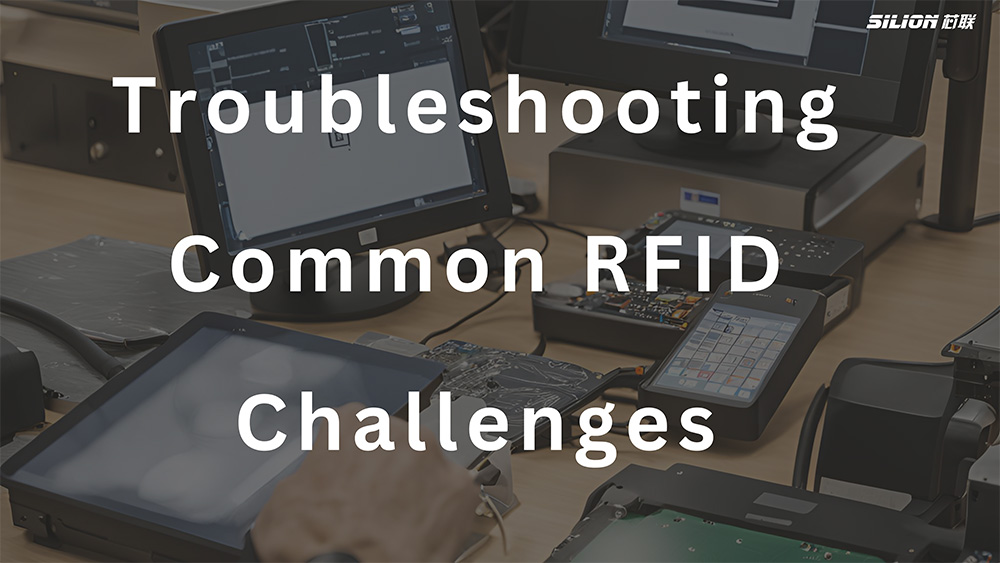Your location: Home Page > RFID Blog | SILION TECH > Troubleshooting Common RFID Challenges
News and Information
Troubleshooting Common RFID Challenges
Author:2024-10-30 16:04:21
RFID (Radio Frequency Identification) technology has revolutionized various industries, from supply chain management to healthcare. However, like any technology, RFID systems can encounter challenges that can hinder their performance. In this blog post, we will explore common RFID challenges and provide practical solutions to overcome them.

Understanding RFID Basics
Before delving into troubleshooting, let's briefly recap the fundamental principles of RFID. An RFID system comprises three essential components:
1. RFID Tag: A small electronic device that stores and transmits data. It consists of a microchip and an antenna.
2. RFID Reader: A device that emits radio waves to activate the RFID tag and receive the data it transmits.
3. Antenna: A component that enables wireless communication between the RFID tag and reader.
Common RFID Challenges and Solutions
1. Tag Interference:
Tag interference occurs when multiple RFID tags are present within the reader's range, leading to signal collisions and inaccurate data transmission.
· Solutions:
o Tag Placement: Ensure proper tag placement to minimize interference. Avoid placing tags too close together or in metal enclosures that can shield the signal.
o Frequency Hopping: Utilize frequency hopping technology, which allows the reader to switch frequencies to reduce interference.
o Time-Division Multiple Access (TDMA): Implement TDMA protocols to allocate specific time slots for each tag to transmit data, preventing collisions.
2. Reader Sensitivity:
Reader sensitivity refers to the reader's ability to detect and read RFID tags at a specific distance. Low sensitivity can result in missed reads or inaccurate data capture.
· Solutions:
o Antenna Placement: Optimize antenna placement to maximize the reader's effective range. Consider factors like antenna orientation and height.
o Reader Power Output: Increase the RFID reader power output to improve signal strength and extend the read range. However, be mindful of regulatory limits and potential interference.
o Tag Sensitivity: Use high-sensitivity RFID tags that can be read at longer distances and in challenging environments.
3. Environmental Factors:
Environmental factors such as temperature, humidity, and electromagnetic interference can significantly impact RFID system performance.
· Solutions:
o Temperature and Humidity Control: Implement measures to regulate temperature and humidity within acceptable limits.
o Shielding: Use shielding techniques to protect RFID systems from electromagnetic interference. Metal enclosures and shielding materials can help mitigate interference from other electronic devices.
o Robust Tag Design: Choose RFID tags designed to withstand harsh environmental conditions, including extreme temperatures and moisture.
4. Data Security:
RFID systems handle sensitive data, making security a critical concern. Unauthorized access or data tampering can lead to severe consequences.
· Solutions:
o Encryption: Employ strong encryption algorithms to protect data transmitted between the RFID tag and reader.
o Authentication: Implement authentication protocols to verify the identity of both the RFID tag and reader.
o Access Control: Limit access to RFID systems to authorized personnel.
5. Power Supply Issues:
Passive RFID tags rely on the energy harvested from the reader's radio waves. Insufficient power can affect tag performance and read range.
· Solutions:
o Reader Power Output: Ensure the reader provides adequate power to activate the tags.
o Tag Placement: Optimize tag placement to maximize the amount of energy received from the reader.
o Tag Battery (for active tags): Regularly monitor and replace batteries in active RFID tags to maintain optimal performance.
Advanced Troubleshooting Techniques
For more complex RFID challenges, advanced troubleshooting techniques can be employed:
· Signal Strength Measurement: Use specialized equipment to measure the signal strength between the RFID tag and reader. This helps identify weak signal areas and optimize system performance.
· Spectrum Analysis: Analyze the radio frequency spectrum to identify potential sources of interference and adjust the system accordingly.
· Tag and Reader Calibration: Calibrate RFID tags and readers to ensure accurate data transmission and reception.
By understanding and addressing these common RFID solutions, you can optimize your RFID system's performance and reliability. Remember, a well-designed and properly implemented RFID system can significantly improve efficiency, accuracy, and security in various applications.